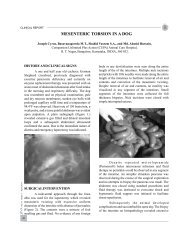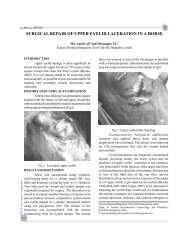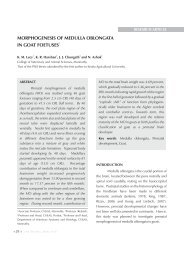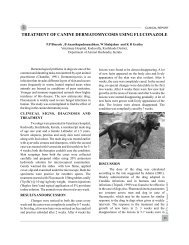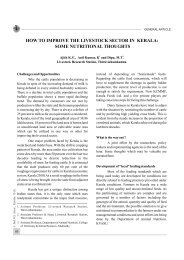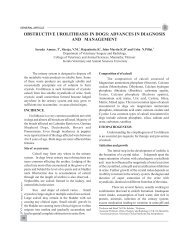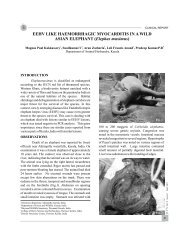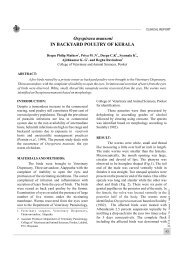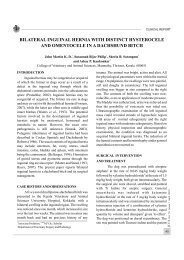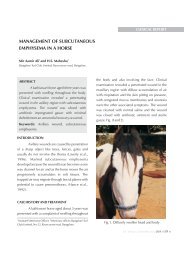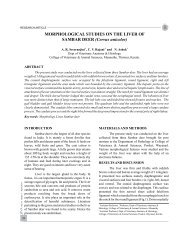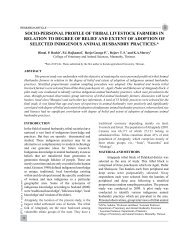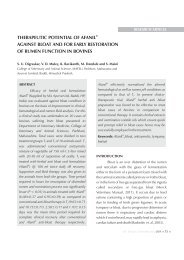termination of pregnancy in bitches - Jivaonline.net
termination of pregnancy in bitches - Jivaonline.net
termination of pregnancy in bitches - Jivaonline.net
You also want an ePaper? Increase the reach of your titles
YUMPU automatically turns print PDFs into web optimized ePapers that Google loves.
GENERAL ARTICLETERMINATION OF PREGNANCY IN BITCHESAbhilash.R.S, Anil kumar.K, Biju.S and Ajith.K.S,Livestock Research Station, Thiruvazhamkunnu, PalakkadJ. Ind. Vet. Assoc., Kerala. 10 (1)INTRODUCTIONTerm<strong>in</strong>ation <strong>of</strong> <strong>pregnancy</strong> is one <strong>of</strong> the mostcommon requests from dog owners. The usualreasons <strong>in</strong>clude too young age, too old age,disproportionate size <strong>of</strong> mat<strong>in</strong>g partners or unwantedor accidental mat<strong>in</strong>g. Over the last 20 years manynew drugs have been used for <strong>term<strong>in</strong>ation</strong> <strong>of</strong><strong>pregnancy</strong> <strong>in</strong> can<strong>in</strong>es. There are different treatmentprotocols such as oestrogen therapy, PGF2 and itsanalogues, dopam<strong>in</strong>e agonists, comb<strong>in</strong>ation <strong>of</strong>prostagland<strong>in</strong>s and dopam<strong>in</strong>e agonists, anti progest<strong>in</strong>therapy etc. Although most <strong>of</strong> these drugs havealready been used for years <strong>in</strong> other species, only feware widely marketed or approved for use <strong>in</strong> dogs. Theaim <strong>of</strong> the present article is to briefly review the stepsto be taken before proceed<strong>in</strong>g with <strong>term<strong>in</strong>ation</strong> <strong>of</strong><strong>pregnancy</strong>, the drugs available for the <strong>term<strong>in</strong>ation</strong> <strong>of</strong><strong>pregnancy</strong> <strong>in</strong> <strong>bitches</strong>, their pharmacologicalproperties and availability.INITIAL EXAMINATIONA thorough history is valuable prior toattempt <strong>term<strong>in</strong>ation</strong> <strong>of</strong> <strong>pregnancy</strong> <strong>in</strong> bitch. Confirmwhether the animal has actually mated or not. Avag<strong>in</strong>al smear is the best diagnostic tool forevaluat<strong>in</strong>g mat<strong>in</strong>g and to f<strong>in</strong>d the stage <strong>of</strong> the cycle.The presence <strong>of</strong> sperm or sperm head confirmsmat<strong>in</strong>g whereas absence <strong>of</strong> sperm does not <strong>in</strong>dicatethat a fertile breed<strong>in</strong>g did not occur. Pregnancyshould be confirmed by ultrasound scann<strong>in</strong>g aroundday 30 <strong>of</strong> the last breed<strong>in</strong>g before start<strong>in</strong>g thetreatment. The po<strong>in</strong>ts to ponder <strong>in</strong> plann<strong>in</strong>g to abort abitch <strong>in</strong>clude its <strong>pregnancy</strong> confirmation and the60safety, reliability and the ease <strong>of</strong> adm<strong>in</strong>istration <strong>of</strong>the drug used.The first stage <strong>of</strong> <strong>pregnancy</strong> beg<strong>in</strong>s atfertilization and ends a few days after implantation.Dur<strong>in</strong>g this time <strong>pregnancy</strong> cannot be confirmed and<strong>in</strong>duction <strong>of</strong> abortion is difficult because <strong>of</strong> therefractory nature <strong>of</strong> corpus luteum to exogenousmedications. Term<strong>in</strong>ation <strong>of</strong> <strong>pregnancy</strong> at this stagecan be attempted with medications like estrogens,prostagland<strong>in</strong>s and anti progest<strong>in</strong>s. Dur<strong>in</strong>g thesecond stage, <strong>pregnancy</strong> can be confirmed andabortion can be <strong>in</strong>duced if necessary. Abortion can be<strong>in</strong>duced with prostagland<strong>in</strong>s, antiprolact<strong>in</strong> agents(dopam<strong>in</strong>e agonists such as bromocript<strong>in</strong>e orcabergol<strong>in</strong>e), comb<strong>in</strong>ation <strong>of</strong> prostagland<strong>in</strong>s anddopam<strong>in</strong>e agonists or with <strong>in</strong>hibitors <strong>of</strong> progesteronesecretions (epostane) or antiprogest<strong>in</strong>s (mifepristoneor aglepristone). Third stage is one that beg<strong>in</strong>s withthe calcification <strong>of</strong> fetal structures and abortion isalways associated with expulsion <strong>of</strong> foetus. In thisstage abortion might <strong>in</strong>duce premature parturitionwith delivery <strong>of</strong> live pups. Hence the best time for<strong>in</strong>itiation <strong>of</strong> abortion protocols <strong>in</strong> <strong>bitches</strong> is betweendays 30 and 35 from the date <strong>of</strong> last breed<strong>in</strong>gINDUCTION OF ABORTION PRIOR TOIMPLANTATIONFertilization <strong>of</strong> eggs and the <strong>in</strong>itial 6-10 days<strong>of</strong> embryonic development take place <strong>in</strong> theoviducts. Large doses <strong>of</strong> estrogens can prolongretention time <strong>of</strong> embryo with<strong>in</strong> the oviduct thatleads to the degeneration and death <strong>of</strong> embryo. Themechanism <strong>of</strong> action <strong>of</strong> oestrogen is <strong>in</strong> two ways,firstly it tightens uterotubal junction and thus
GENERAL ARTICLEprolong oviductal retention <strong>of</strong> embryos and secondlyoestrogen has direct degenerative effects on ova andmay alter the endometrium.1. OESTROGENSOestrogens are widely used to preventunwanted pregnancies. They act by alter<strong>in</strong>g thetransport time <strong>of</strong> zygotes and thus <strong>in</strong>terfer<strong>in</strong>g withimplantation. In some <strong>bitches</strong> estrogens given dur<strong>in</strong>goestrus results <strong>in</strong> early luteolysis and this effect maybe mediated either directly upon luteal progesteroneproduction or by <strong>in</strong>hibition <strong>of</strong> LH release which isluteotrophic.a. Diethyl Stilbesterol (DES)Injection <strong>of</strong> DES at a dose rate <strong>of</strong> 2mg/kgbody weight, up to 25mg once or twice with<strong>in</strong> 5 days<strong>of</strong> mat<strong>in</strong>g is found to be highly effective <strong>in</strong>term<strong>in</strong>at<strong>in</strong>g <strong>pregnancy</strong>. However <strong>in</strong>jectable DES isnot available for veter<strong>in</strong>ary practice. Oral DES hasbeen recommended at a dosage <strong>of</strong> 1 to 2 mg/day for 7days after mat<strong>in</strong>g, but oral therapy has not been foundto be completely reliable.b. Oestradiol cypionateIt was an oestrogen compound commonlyused by veter<strong>in</strong>arians for the management <strong>of</strong>unwanted mat<strong>in</strong>g. The treatment protocol <strong>in</strong>volved isadm<strong>in</strong>istration <strong>of</strong> 0.25 to 1 mg total dose with<strong>in</strong> 3days <strong>of</strong> mat<strong>in</strong>g. A dose rate <strong>of</strong> 0.04 mg /kg is 100percent successful <strong>in</strong> prevent<strong>in</strong>g <strong>pregnancy</strong> <strong>in</strong><strong>bitches</strong>. The total dose should not exceed 1mg.Despite the potentially favourable action on<strong>term<strong>in</strong>ation</strong> <strong>of</strong> <strong>pregnancy</strong>, it has major side effectssuch as permanent bone marrow suppression ordestruction result<strong>in</strong>g <strong>in</strong> severe anaemia, leukopenia,thrombocytopenia and death.c. Conjugated oestrogenConjugated oestrogens can be used for thetreatment <strong>of</strong> misalliance <strong>in</strong> dogs with<strong>in</strong> 5 daysfollow<strong>in</strong>g breed<strong>in</strong>g. They are ma<strong>in</strong>ly isolated frommare's ur<strong>in</strong>e and hence it can be called as conjugatedequ<strong>in</strong>e oestrogen. Most commonly used for thetreatment <strong>of</strong> osteoporosis, atrophic vag<strong>in</strong>itis,atrophic urethritis etc as a complication <strong>of</strong>menopause <strong>in</strong> woman. Commonly availablepreparation is PREMARIN 0.625mg and 1.25mgtablets. Dosage 1.875mg daily for 3 daysHowever estrogens can result <strong>in</strong> thedevelopment <strong>of</strong> pyometra by caus<strong>in</strong>g cervicalrelaxation thus allow<strong>in</strong>g the vag<strong>in</strong>al bacteria to enterthe uterus. Estrogens may also produce dose relatedbone marrow suppression. Diethyl stilbesterol,oestradiol benzoate and estradiol cypionate havebeen widely used to prevent implantation.But oestrogen preparations are notrecommended <strong>in</strong> veter<strong>in</strong>ary practice because <strong>of</strong> theirharmful side effects. Oestrogen is thought topredispose pyometra <strong>in</strong> <strong>bitches</strong> by sensitiz<strong>in</strong>gprogesterone receptors and enhanc<strong>in</strong>g b<strong>in</strong>d<strong>in</strong>g <strong>of</strong>progesterone to the endometrium. It has been alsoreported that excess serum estrogens can lead tooestrogen- <strong>in</strong>duced bone marrow destruction.2. PROSTAGLANDINS ANDITS ANALOGUESPregnancy <strong>in</strong> the bitch depends onprogesterone secretion from corpora lutea. Manystudies <strong>in</strong>dicate that <strong>bitches</strong> that have corpora luteaare relatively resistant to the luteolytic effects <strong>of</strong>prostagland<strong>in</strong>s dur<strong>in</strong>g the first 14 to 28 days <strong>of</strong><strong>pregnancy</strong>. PGF2 (Natural Prostagland<strong>in</strong>s ieD<strong>in</strong>oprost) is luteolytic and uterotonic, <strong>in</strong>duc<strong>in</strong>g<strong>in</strong>tense uter<strong>in</strong>e contractions due to the smoothmuscle contraction effects and may lead to adversereactions. Synthetic analogs (cloprostenol sodium)characterized by more specific activity on the corpusluteum and less on smooth muscle stimulationproperties have fewer side effects.A. Natural Prostagland<strong>in</strong>: - Prostagland<strong>in</strong>s arefound to be highly effective for <strong>term<strong>in</strong>ation</strong> <strong>of</strong><strong>pregnancy</strong> <strong>in</strong> <strong>bitches</strong> after 30 days <strong>of</strong> gestation. Itsuse prior to 30 day is not recommended. Mostpreferred treatment protocol is 0.1 mg/kg s/c every 8hours for 2 days and then 0.2 mg/kg given s/c every 8hours until abortion complete, the average wasJIVA Vol. 10 Issue 1 April 201261
GENERAL ARTICLEJ. Ind. Vet. Assoc., Kerala. 10 (1)approximately 5-7 days (Feldman et.al, 1993 andRenukaradhya et.al, 2008). This protocol resulted <strong>in</strong>the least side effects. After adm<strong>in</strong>istration <strong>of</strong> drug,the dog should be observed for 30 m<strong>in</strong>utes for anyside effects. The dog should be fed 1-2 hours afterprostagland<strong>in</strong> <strong>in</strong>jection so as to avoid vomit<strong>in</strong>g. It hasbeen observed that plasma progesterone less than 2.0ng / ml result <strong>in</strong> <strong>pregnancy</strong> <strong>term<strong>in</strong>ation</strong> and pretreatment concentration <strong>of</strong> plasma progesterone ismore than 6ng/ml (Feldman et.al, 1993). Most <strong>of</strong> theanimals treated will exhibit some <strong>of</strong> the follow<strong>in</strong>gside effects like pant<strong>in</strong>g, respiratory distress, excesssalivation, vomit<strong>in</strong>g, defecation, stranguria andur<strong>in</strong>ation. Normally these side effects start with<strong>in</strong> 30seconds to 3 m<strong>in</strong>utes and usually persist for 5-20m<strong>in</strong>utes. Side effects are usually severe dur<strong>in</strong>g thefirst few <strong>in</strong>jections and side effects will bedim<strong>in</strong>ish<strong>in</strong>g after each subsequent <strong>in</strong>jection.Preparation - LUTALYSE 5ml &10ml vials areavailable. Concentration 5mg/mlb. Prostagland<strong>in</strong> analogs:- It has greater luteolyticeffectiveness at relatively low doses and decreasesthe occurrence <strong>of</strong> myometrial contractions andseverity <strong>of</strong> side effects compared to naturalprostagland<strong>in</strong>s. It has much greater aff<strong>in</strong>ity for theprostagland<strong>in</strong> receptors and has a longer half life thannatural prostagland<strong>in</strong>. It can be given at the dose rate<strong>of</strong> 2.5µg/Kg body weight subcutaneously every 48hours for 3 to 4 times (Reddy et.al, 2010). In order toreduce the side effects atrop<strong>in</strong>e sulphate can be givenat the rate <strong>of</strong> 0.04 mg/kg body weight subcutaneously10-15 m<strong>in</strong>utes prior to the adm<strong>in</strong>istration <strong>of</strong> drug.Preparation Inj.Clostenol 2ml, Inj.Pragma2ml,Inj.Cyclix 2ml, Inj. Estropur 2ml Concentration-250µg/ml3. DOPAMINE AGONISTSDopam<strong>in</strong>ergic agonists are ergot<strong>in</strong>ederivativealkaloid compounds that exert an antiprolact<strong>in</strong>ergiceffect. The ability <strong>of</strong> dopam<strong>in</strong>eagonists to <strong>in</strong>hibit prolact<strong>in</strong> secretion makes themoptimal for milk suppression, either dur<strong>in</strong>g overtpseudo<strong>pregnancy</strong> episodes or <strong>in</strong> the post-partumperiod. It is well known that prolact<strong>in</strong> is a requiredluteotropic hormone dur<strong>in</strong>g the second half <strong>of</strong> can<strong>in</strong>eluteal phase. Therefore, anti-prolact<strong>in</strong>s can also beused to suppress luteal function <strong>in</strong> progesteronedependent conditions such as pyometra, unwanted<strong>pregnancy</strong> and mammary tumors. Two <strong>of</strong> the mostwidely used dopam<strong>in</strong>e agonists <strong>in</strong> dogs arebromocript<strong>in</strong>e and cabergol<strong>in</strong>e, which have a directaction on D2-dopam<strong>in</strong>e receptors <strong>of</strong> the lactotrophiccells <strong>of</strong> the anterior pituitary gland.a. Bromocript<strong>in</strong>e: - It has been reported to be aneffective abortifacient after 35 days <strong>of</strong> gestation butnot prior to day 30. Two different treatment protocolshave been adopted. In one protocol 0.1mg/kg bodyweight daily or BID for 6 consecutive daysbeg<strong>in</strong>n<strong>in</strong>g on day 30 <strong>of</strong> gestation. In the secondprotocol, 0.03 mg/kg twice daily for 4 daysbeg<strong>in</strong>n<strong>in</strong>g after day 30 <strong>of</strong> gestation. Bromocript<strong>in</strong>ecommonly causes <strong>in</strong>appetence, anorexia, vomit<strong>in</strong>gand depression. Also the drug is not 100% effective<strong>in</strong> term<strong>in</strong>at<strong>in</strong>g <strong>pregnancy</strong>. Emesis is presumably dueto <strong>in</strong>teraction with dopam<strong>in</strong>ergic elements <strong>in</strong> theemesis centre <strong>of</strong> the bra<strong>in</strong> and the ability <strong>of</strong> the drugto cross the blood bra<strong>in</strong> barrier. The emetic effectmay reduce the absorption <strong>of</strong> the total doseadm<strong>in</strong>istered, and thus compromise efficacy.Because <strong>of</strong> above reasons the drug has not been usedextensively. Preparation ENCRIPT 2.5 mg tab,PROCTINAL 1.25 & 2.5 mg tabs.b. Cabergol<strong>in</strong>e: - It is a long act<strong>in</strong>g dopam<strong>in</strong>ereceptor agonist and prolact<strong>in</strong> <strong>in</strong>hibitor. It is highlyeffective orally and parenterally. A dose <strong>of</strong> 5µg/kgonce daily cause a sharp decl<strong>in</strong>e <strong>in</strong> serum prolact<strong>in</strong>concentration and result <strong>in</strong> abortion without muchside effects (Reddy et.al, 2010).. The side effects <strong>of</strong>cabergol<strong>in</strong>e are milder (compared to those <strong>of</strong>bromocript<strong>in</strong>e) presumably due to the fact that itappears to be a more specific D-2 dopam<strong>in</strong>e receptoragonist and is less able to cross the blood-bra<strong>in</strong>barrier and have CNS effects.Preparation CABGOLIN Tab 0.25 & 0.5mg, CAMFORTE Tab 0.5 & 1mg62
GENERAL ARTICLE4. COMBINATION OF PROSTAGLANDINAND DOPAMINE AGONISTSimultaneous adm<strong>in</strong>istration <strong>of</strong> prostagland<strong>in</strong>and dopam<strong>in</strong>e agonist is found to be highly effective.Therapy beg<strong>in</strong>s 28 days after first breed<strong>in</strong>g.Cloprostenol is adm<strong>in</strong>istered subcutaneously onalternative days at a dose rate <strong>of</strong> 1 µg/kg and the drughas to be adm<strong>in</strong>istered three times. Oral cabergol<strong>in</strong>ehas to be given at a dose rate <strong>of</strong> 5µg/kg body weightfor 9 days. This regimen reduces the adverse effects<strong>of</strong> prostagland<strong>in</strong> therapy alone and <strong>in</strong>creases theefficacy <strong>of</strong> prolact<strong>in</strong> antagonists. When the <strong>bitches</strong>were treated for approximately 9 days, 100 percentshowed resorption and there was generally no sideeffects except sangu<strong>in</strong>ous vag<strong>in</strong>al discharge (Oncl<strong>in</strong>et.al, 1995).5. ANTI PROGESTERONE THERAPYAnti-progest<strong>in</strong>s are synthetic steroids thatb<strong>in</strong>d with great aff<strong>in</strong>ity to progesterone receptors,prevent<strong>in</strong>g progesterone from exert<strong>in</strong>g its biologicaleffects. After adm<strong>in</strong>istration <strong>of</strong> the drug peripheralprogesterone concentration rema<strong>in</strong>s unaltered but itsaction is blocked. In dogs, the anti-progest<strong>in</strong>smifepristone and aglepristone have been used forexperimental and cl<strong>in</strong>ical purposes, <strong>in</strong>clud<strong>in</strong>g<strong>pregnancy</strong> <strong>term<strong>in</strong>ation</strong> and management <strong>of</strong>pyometra.a. Mifepristone: -Mifepristone is a progesterone andglucocorticoid antagonist. It is more potent as ananti-progest<strong>in</strong> than as an anti-corticoid. In pregnantwomen, mifepristone is able to <strong>in</strong>terrupt early<strong>pregnancy</strong> <strong>in</strong> 80 percent <strong>of</strong> cases without any majorside effects. To improve its efficacy, mifepristone iscurrently used <strong>in</strong> comb<strong>in</strong>ation with low doses <strong>of</strong>prostagland<strong>in</strong> analogs such as misoprostol. Theefficacy <strong>of</strong> comb<strong>in</strong>ed treatment (mifepristone plusmisoprostol) is 96 percent <strong>in</strong> humans. The drug act asa progesterone receptor antagonist at the level <strong>of</strong> theuterus <strong>in</strong>dependent <strong>of</strong> any additional effects on lutealfunction. Premature cessation <strong>of</strong> luteal function mayhave occurred secondary to the <strong>term<strong>in</strong>ation</strong> <strong>of</strong><strong>pregnancy</strong> or may represent a luteolytic effect <strong>of</strong>treatment <strong>in</strong>dependent <strong>of</strong> <strong>pregnancy</strong> status.Mifepristone has been demonstrated to <strong>in</strong>duce directluteolysis and has an anticorticoid activity.This drug is orally active and has beenshown to be safe and effective <strong>in</strong> term<strong>in</strong>at<strong>in</strong>g<strong>pregnancy</strong> after 30 days <strong>of</strong> gestation. The treatmentprotocol <strong>in</strong>volved oral adm<strong>in</strong>istration <strong>of</strong> drug at therate <strong>of</strong> 2.5 mg/kg twice daily for 4-5 days or untilabortion or resorption occurred (Concanoon et.al,1990). It is a competitive antagonist <strong>of</strong> progesteroneon the receptor level thus hav<strong>in</strong>g most cl<strong>in</strong>ical effects<strong>in</strong> the presence <strong>of</strong> progesterone. Preparation Tab.MTPILL 200mg, MEFIPIL 200mg, UNWANTED200mgB. Aglepristone: - This is a relatively newantiprogesterone drug developed for animal use.Aglepristone can be used any time up to day 45 forsafe effective <strong>term<strong>in</strong>ation</strong> <strong>of</strong> <strong>pregnancy</strong> (Fieni et. al,2001). Aglepristone does not modify plasmaconcentrations <strong>of</strong> progesterone, prostagland<strong>in</strong>s,oxytoc<strong>in</strong> or cortisol with<strong>in</strong> 24 hours after itsadm<strong>in</strong>istration but <strong>in</strong>duces an <strong>in</strong>crease <strong>in</strong>concentrations <strong>of</strong> prolact<strong>in</strong> with<strong>in</strong> 12 hours <strong>in</strong> <strong>bitches</strong>treated <strong>in</strong> mid <strong>pregnancy</strong> (Galac, et. al, 2000). Thiscan expla<strong>in</strong> the mammary gland congestion typicallyobserved after mid <strong>pregnancy</strong> <strong>term<strong>in</strong>ation</strong>.Shorten<strong>in</strong>g <strong>of</strong> the <strong>in</strong>ter-oestrous <strong>in</strong>terval andprolact<strong>in</strong> release seems to prove a direct or <strong>in</strong>directaction <strong>of</strong> aglepristone on hypothalamic-pituitaryaxis. As an abortifacient, aglepristone acts like aprogesterone antagonist, at the uterus level and doesnot have direct and immediate luteolysis properties.Term<strong>in</strong>ation <strong>of</strong> <strong>pregnancy</strong> occurs <strong>in</strong> the presence <strong>of</strong>high plasma progesterone concentrations (Baa<strong>net</strong>.al, 2005)..The early adm<strong>in</strong>istration <strong>of</strong> aglepristone at 0to 25 days after mat<strong>in</strong>g always resulted <strong>in</strong> prevention<strong>of</strong> <strong>pregnancy</strong>. The later adm<strong>in</strong>istration <strong>of</strong>aglepristone at day 26 to 45 after mat<strong>in</strong>g <strong>in</strong>ducedresorbtion or abortion with<strong>in</strong> seven days <strong>in</strong> 96percent <strong>of</strong> cases. There were no untoward sideeffects. The drug can be adm<strong>in</strong>istered at a dosage <strong>of</strong>JIVA Vol. 10 Issue 1 April 201263
GENERAL ARTICLEJ. Ind. Vet. Assoc., Kerala. 10 (1)10mg/kg body weight (0.33ml/kg/day)subcutaneously twice at 24 hour <strong>in</strong>terval. Efficacy <strong>of</strong>treatment for <strong>term<strong>in</strong>ation</strong> <strong>of</strong> <strong>pregnancy</strong> is reported tobe 95 percent. No side effects were observed exceptmammary development and lactation. PreparationALIZIN 10 ml vial 30 mg/ml.6. OGESTERONE SYNTHESIS INHIBITORSProgesterone production can be blocked bythe hydroxyl steroid dehydrogenase isomeraseenzyme <strong>in</strong>hibitors, which prevent the conversion <strong>of</strong>prognenelone to progesterone. Prognenelone isbiologically <strong>in</strong>active, and therefore progesteronesupport for the <strong>pregnancy</strong> is lost, result<strong>in</strong>g <strong>in</strong>resorption or abortion (Simpson, 1998). Epostane isone such enzyme <strong>in</strong>hibitor that has no <strong>in</strong>tr<strong>in</strong>sicoestrogenic, androgenic or progestogenic activity.When adm<strong>in</strong>istered subcutaneously at the onset <strong>of</strong>metoestrus (dioestrus), epostane will prevent orterm<strong>in</strong>ate <strong>pregnancy</strong>. It can be given at a dose rate <strong>of</strong>5mg/kg body weight orally for 7 days (Keister et. al,1989).7. TAMOXIFEN CITRATEIt acts as an antiestrogen <strong>in</strong> premenopausalwomen but has estrogenic activity <strong>in</strong> dogs. It may<strong>in</strong>terfere with zygote transport and/or implantation.Relatively high doses <strong>of</strong> drug are given twice dailydur<strong>in</strong>g proestrus, oestrus, and early metoestrus. Thedrug was effective <strong>in</strong> prevent<strong>in</strong>g or term<strong>in</strong>at<strong>in</strong>g<strong>pregnancy</strong> if adm<strong>in</strong>istration began dur<strong>in</strong>g proestrusor estrus or on day 2 <strong>of</strong> estrus. Efficacy was muchpoor <strong>in</strong> if the treatment commenced on day 15onwards. It can be given at a dose rate <strong>of</strong> 1mg/kgorally twice a day for 10 days. A high <strong>in</strong>cidence <strong>of</strong>pathological changes <strong>in</strong> the bitch's reproductive tractis <strong>in</strong>duced by tamoxifen, <strong>in</strong>clud<strong>in</strong>g ovarian cysts andendometritis, and the compound is <strong>of</strong> little value forpotential breed<strong>in</strong>g animals (Bowen et.al, 1988).Preparation TAMOFEN Tab 10 mg, TAMOXIFENTab 10, 20 and 40 mg.8. EMBRYOTOXIC AGENTSSeveral novel embryotoxic agents such asphenyltriazole iso<strong>in</strong>dole and isoqu<strong>in</strong>ol<strong>in</strong>ecompounds have been evaluated <strong>in</strong> the bitch. Theyare most effective when given around the time <strong>of</strong>implantation and <strong>of</strong>ten only a s<strong>in</strong>gle adm<strong>in</strong>istration isrequired. A s<strong>in</strong>gle sub cutaneous or <strong>in</strong>tra muscular<strong>in</strong>jection <strong>of</strong> 2-(3-ethoxy-phenyl)-5, 6-dihydro-striazole[5,1-a]isoqu<strong>in</strong>ol<strong>in</strong>e(DL 204-IT) dissolved orsuspended <strong>in</strong> an oily vehicle is sufficient. Theoptimal time <strong>of</strong> treatment was found to be day 20 <strong>of</strong>gestation, at which time the smallest effective dosewas 6.25 ng/kg (Galliani et. al, 1982). Howevermany <strong>of</strong> these agents have toxic side effects<strong>in</strong>clud<strong>in</strong>g vomit<strong>in</strong>g, diarrhoea, weight loss, pyrexia,lethargy and immunosuppression.9. DEXAMETHAZONEDexamethasone adm<strong>in</strong>istered beg<strong>in</strong>n<strong>in</strong>g atmid-gestation can term<strong>in</strong>ate <strong>pregnancy</strong> <strong>in</strong> dogs,presumably by activat<strong>in</strong>g endogenous mechanismssimilar to those <strong>in</strong>volved <strong>in</strong> parturition. It can result<strong>in</strong> the production <strong>of</strong> oestrogen and prostagland<strong>in</strong> bythe fetoplacental unit. S<strong>in</strong>gle dose <strong>of</strong> glucocorticoidsare not efficacious <strong>in</strong> the bitch. It can be given at adose rate <strong>of</strong> 200µg/kg body weight for 7 days andthen at a taper<strong>in</strong>g dose <strong>of</strong> 10-20 µg/kg for next 3 days(Wanke et. al, 2002). Advantages <strong>of</strong> such a therapyfor <strong>pregnancy</strong> <strong>term<strong>in</strong>ation</strong> <strong>in</strong>clude the fact that it<strong>in</strong>volves only oral adm<strong>in</strong>istration <strong>of</strong> a relatively<strong>in</strong>expensive drug; however repeated adm<strong>in</strong>istrationand high doses make the method impractical.Preparation: - DEXONA Tab 0.5mg, WYMESONETab 0.5 mgCONCLUSIONBefore decid<strong>in</strong>g treatment for misalliance,vag<strong>in</strong>al cytology should be performed to make surethat mat<strong>in</strong>g had taken place. Aglepristone,oestrogens and tamoxifen citrate are the drugs whichcan be preferred for the treatment <strong>of</strong> misalliance <strong>in</strong>64
GENERAL ARTICLEdogs. Among these aglepristone is the best drug <strong>of</strong>choice. Due to adverse side effects diethylstilbesterol and tamoxifen citrate are not preferred.Dur<strong>in</strong>g mid gestation from 28-30 days onwardssynthetic prostagland<strong>in</strong>s, anti prolact<strong>in</strong>s andantiprogesterone therapy are found to be effective. Acomb<strong>in</strong>ation <strong>of</strong> prostagland<strong>in</strong> and antiprolact<strong>in</strong>(cabergol<strong>in</strong>e) is found to be highly effective <strong>in</strong>term<strong>in</strong>at<strong>in</strong>g <strong>pregnancy</strong>. This treatment has theadvantages <strong>of</strong> be<strong>in</strong>g free <strong>of</strong> side effects, it <strong>in</strong>ducesabortions by resorption, and it works as early as day25. The embryo toxic agents such as phenyltriazoleiso<strong>in</strong>dole and isoqu<strong>in</strong>ol<strong>in</strong>e compounds are drugswhich can be tried for <strong>pregnancy</strong> <strong>term<strong>in</strong>ation</strong> but thetoxic side effects limits its use <strong>in</strong> dogs.REFERENCEBaan, M, Taverne, M.A.M, Kooistra,H.S, J. deGier, Dieleman, S.J and Okkens, A.C (2005)“Induction <strong>of</strong> parturition <strong>in</strong> the bitch with theprogesterone-receptor blocker aglépristone”Theriogenology Volume 63, Issue 7 , Pages1958-1972, 15 April 2005Bowen RA, Olson PN, Young S, Withrow SJ. 1988“Efficacy and toxicity <strong>of</strong> tamoxifen citrate forprevention and <strong>term<strong>in</strong>ation</strong> <strong>of</strong> <strong>pregnancy</strong> <strong>in</strong><strong>bitches</strong>” Am. J. Vet. Res. Jan; 49 (1):27-31.Concannon PW, Yeager A, Frank D, Iyampillai A.1990 “Term<strong>in</strong>ation <strong>of</strong> <strong>pregnancy</strong> and <strong>in</strong>duction<strong>of</strong> premature luteolysis by the antiprogestagen,mifepristone, <strong>in</strong> dogs” J. Reprod. Fertil. Jan;88(1):99-104.Feldman EC, Davidson AP, Nelson RW, Nyland TG,Munro C 1993 Prostagland<strong>in</strong> <strong>in</strong>duction <strong>of</strong>abortion <strong>in</strong> pregnant <strong>bitches</strong> after misalliance J.Am. Vet. Med. Assoc. Jun 1;202(11):1855-8.Fieni,F, J.F. Bruyas, I. Battut and D. Ta<strong>in</strong>turier 2001“Cl<strong>in</strong>ical Use <strong>of</strong> Anti-Progest<strong>in</strong>s <strong>in</strong> the Bitch”International Veter<strong>in</strong>ary Information Service,Ithaca NY (www.ivis.org), A1219.0201Galac,S, H.S. Kooistra,J. But<strong>in</strong>ar, M.M. Bevers, S.J.Dieleman, G. Voorhout, A.C. Okkens 2000Term<strong>in</strong>ation <strong>of</strong> mid-gestation <strong>pregnancy</strong> <strong>in</strong><strong>bitches</strong> with aglepristone, a progesteronereceptor antagonist. Theriogenology, Volume53, Issue 4 , Pages 941-950.Galliani, G, Lernerm, L.J, Caramel, C., Marasch<strong>in</strong>.R, Nani, S., Nava, A, Nava, A. 1982 “Pregnancy<strong>term<strong>in</strong>ation</strong> <strong>in</strong> dogs with novel non-hormonalcompounds. Studies <strong>of</strong> 2-(3-ethoxy-phenyl)-5,6-dihydro-s-triazole [5,1-a] isoqu<strong>in</strong>ol<strong>in</strong>e (DL204-IT)” Arzneimittelforschung. 32 (2): 123-7.Gilian, M. Simpson. 1998 Basava Manual <strong>of</strong> SmallAnimal Reproduction and Neonatology.Published by British Small Animal Veter<strong>in</strong>aryAssociation, United K<strong>in</strong>gdom pp 121-124Keister DM, Gutheil RF, Kaiser LD, D'Ver AS 1989Efficacy <strong>of</strong> oral epostane adm<strong>in</strong>istration toterm<strong>in</strong>ate <strong>pregnancy</strong> <strong>in</strong> mated laboratory <strong>bitches</strong>J. Reprod. Fertil. Suppl. 39:241-9.Onchn, K., L. D. M. Silva and J. P. Verstegen 1995Term<strong>in</strong>ation <strong>of</strong> unwanted Pregnancy <strong>in</strong> dogswith the dopam<strong>in</strong>e agonist, cabergol<strong>in</strong>e, <strong>in</strong>comb<strong>in</strong>ation with a synthetic analog <strong>of</strong>pcxzalpha, either cloprostenol or alphaprostol.Theriogenology 43:813-622.Reddy,R.C.K., Sadasiva Rao,K, Solomon Raju, K.G,K.B.Raghavender and A. Gopal Reddy 2010Ind. J. Anim. Reprod. 31(2) 19-22Renukaradhya, G.J, Krishnaswamy, A. andHonnappa,T.G (2008) Studies on the<strong>term<strong>in</strong>ation</strong> <strong>of</strong> <strong>pregnancy</strong> <strong>in</strong> <strong>bitches</strong> us<strong>in</strong>gnatural prostagland<strong>in</strong>s. National Symposium onRecent trends and Future Strategies forimproved Reproduction <strong>of</strong> Livestock,Companion and wild animals pp - 186Wanke, M.M, S. Romagnoli, J. Verstegen and P. W.Concannon 2002 Pharmacological Approachesto Pregnancy Term<strong>in</strong>ation <strong>in</strong> Dogs and CatsInclud<strong>in</strong>g the Use <strong>of</strong> Prostagland<strong>in</strong>s, Dopam<strong>in</strong>eAgonists, and Dexamethasone InternationalVeter<strong>in</strong>ary Information Service (www.ivis.org),Ithaca, New York, USAJIVA Vol. 10 Issue 1 April 201265




